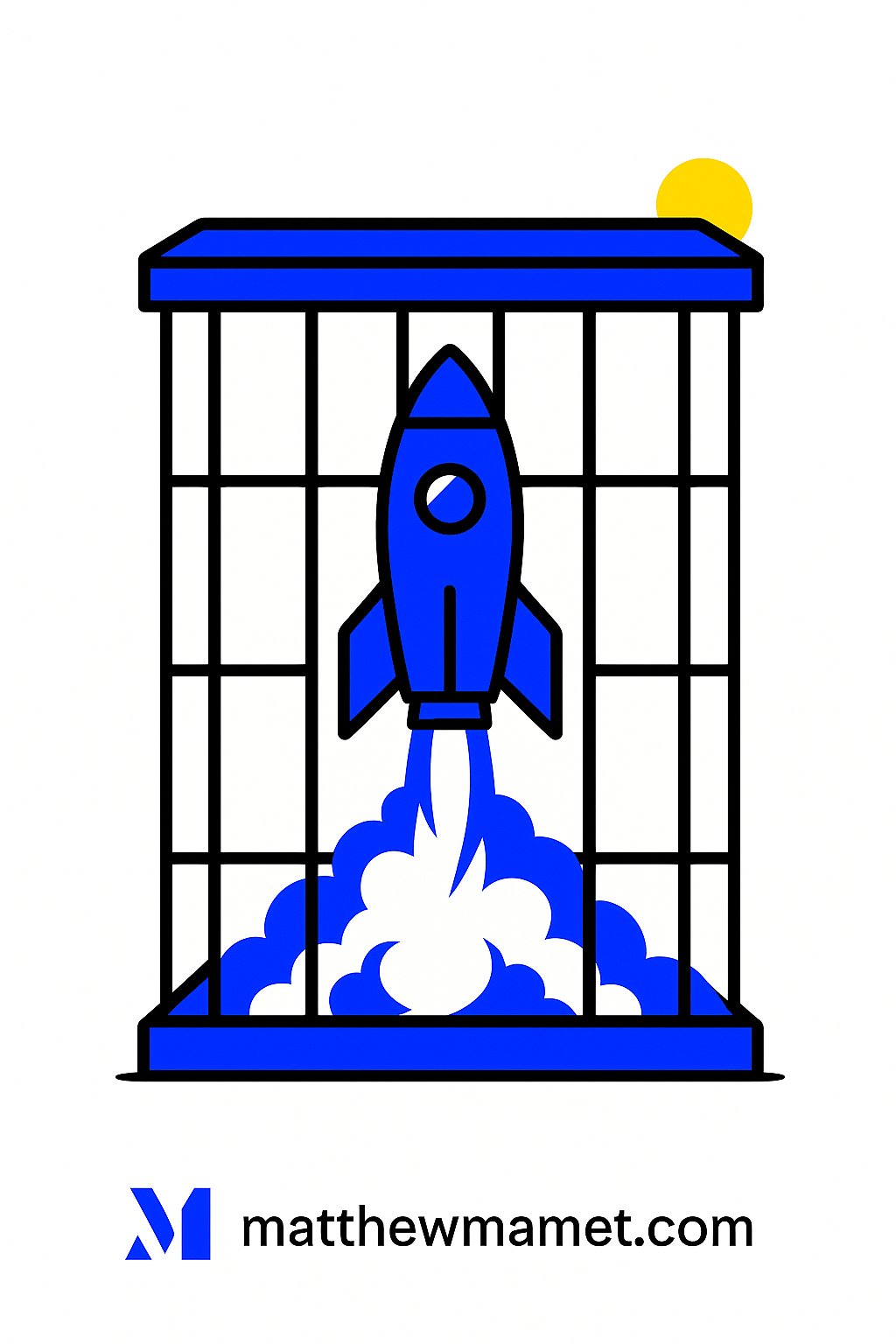Table of Contents
When “Move Fast” Meets “Don’t Screw Up”
Key Challenges That Handcuff Innovation
1. The Quarterly Reporting Grip
2. Compliance and Process Overload
3. Risk: Designed Out of the System
5. Talent Retention - The Double-Edged Sword
What Actually Works: Tactics From The Trenches
Make Constraints Explicit - And Then Hack Around Them
Protect Small Teams, Not Big Projects
Decouple Innovation Timelines From Reporting
Reward Experiments, Not Just Outcomes
Find Ways to Run Real Customer Tests
Teach Leaders How to Embrace Reality
Challenges vs. What Actually Works
Reflection: Think Like a Portfolio Manager, Not a Lone Hacker
When “Move Fast” Meets “Don’t Screw Up”
If you’ve ever worked at a public company - especially in product or R&D - you know the routine. You’re hired for your creativity, pushed to innovate, and measured (relentlessly) on delivering new things. But there’s a catch. Everything you do gets run through the gauntlet of quarterly earnings, compliance, and a dozen layers of just-in-case.
Here’s how it really plays out: You bring a big idea to the table. Everyone loves it in theory, but then legal, finance, and ops weigh in. The idea gets sliced, diced, reframed, and, if you’re not stubborn, completely defanged. The result? Safe, incremental improvements dressed up as “disruption.”
Why is this so hard? Because public companies - by design - run on predictability and risk aversion. Innovation, real innovation, is messy by nature. There’s always a trade-off: quarter-to-quarter optics versus long-term bets.
Key Challenges That Handcuff Innovation
Let’s get specific. In my work with SaaS and marketplace execs, I see the same roadblocks pop up again and again:
1. The Quarterly Reporting Grip
Every 90 days, the spotlight’s on. Miss your numbers - even by a little - and leadership feels the heat. Market analysts, activist investors, and boards don’t care about your future vision. They want clean, clear results now. So what happens to big innovation bets? They get punted down the road, or worse, they’re only presented if they happen to be “sure things.”
It’s not just abstract pressure. It’s very concrete: features shipped for optics, shaky pilots dressed up as launches, teams reallocated to “Q4 impact” projects instead of fundamentals.
2. Compliance and Process Overload
After your IPO, every process gets heavier. Privacy? Layer it on. Security reviews? Double length. Internal audits? Inescapable. Mature companies need this, but the drag is real. By the time you’re cleared to test your new product with real users, the startup working on the same idea is already growing in the wild.
3. Risk: Designed Out of the System
Executives at public companies are, frankly, scared to look foolish. Failure stories play out in the press, not just conference rooms. So entire systems and approval flows are built to avoid “oops” moments. This means fewer experiments, way more alignment meetings, and a culture where saying no (“let’s revisit in Q3”) is safer than yes.
Ready to drive more growth & achieve bigger impact?
Leverage my 25+ years of successes and failures to unlock your growth and achieve results you never thought possible.
Get Started4. Slow, Siloed Teams
Bigger org = more handoffs = more diluted ideas. Maybe the original team was excited about your new approach to customer feedback, but by the time it passes through compliance, legal, and three steering committees, it’s become a 10% tweak and months behind schedule. Momentum dies not from bad intent, but death-by-collaboration.
5. Talent Retention - The Double-Edged Sword
Ambitious product thinkers want to ship, learn, and improve fast. But bureaucracy frustrates them, and eventually, they leave for smaller, nimbler teams. The folks who stay? Often the ones happiest in the “steady state” world - ironically, further tilting the culture away from the edgy creativity public companies desperately need.
What Actually Works: Tactics From The Trenches
I see teams who do break through. Here’s what they have in common:
Make Constraints Explicit - And Then Hack Around Them
The strongest leaders map out their constraints early. Instead of pretending the process won’t gum things up, they tackle it head-on. One CTO I coach did this by actually mapping the “innovation killer” steps in the launch process, then building shadow processes to pressure-test ideas before they hit formal review.
Counterintuitive? Maybe. But it works. If you can prototype, test with beta users, and line up proof points before the machinery kicks in, your ideas have a shot. HubSpot’s experience in their journey towards lean methodology is a textbook example - staying nimble in a world built for routine. (Full story here)
Protect Small Teams, Not Big Projects
You don’t scale innovation by forming bigger “task forces.” You do it by carving off small, protected teams who sit outside the mainline reporting structure. Their mandate is simple: Ship, learn, repeat. If you can get the board and C-suite not to breathe down their necks, you have a fighting chance.
In New England’s innovation hub, this approach stands out: resourceful, trusted teams produce more actual change than giant rollouts. (Check out this piece)
Decouple Innovation Timelines From Reporting
Some things make sense on a quarterly clock. But real innovation takes longer. The best leaders draw a bright line between “optimizing for this quarter” and “building for next year.” How? Through clear portfolio management - and saying no to endless “quick win” requests that sap team energy.
If you can show, on paper, how 10% of your resources are firewalled for big bets, you can defend that line - even when Wall Street’s breathing fire.
Reward Experiments, Not Just Outcomes
Public company comp structures favor certainty. That’s smart - until you want boldness. Flip the script: Give out visible recognition, even small bonuses, for well-run experiments, even when they fail. Share what you learned, not just what “worked.” It’s not touchy-feely; it’s how you reboot creative energy for the long haul.
Find Ways to Run Real Customer Tests
Here’s another hack: Some leaders get clever and use “semi-official” channels to validate early ideas - think beta lists, internal communities, or special pilots with favorite customers. In heavily regulated spaces, you can even run “shadow” evals, stripped of brand, to see what actually gets traction. It’s less risky than full-scale launches, and you get proof fast.
Teach Leaders How to Embrace Reality
“Vision” is great, but most execs in public companies benefit more from leadership coaching on managing inside the box. Spend time each quarter coaching your top people on the difference between calculated risks and reckless bets - and how to message both inside and outside the company.
Ready to drive more growth & achieve bigger impact?
Leverage my 25+ years of successes and failures to unlock your growth and achieve results you never thought possible.
Get StartedChallenges vs. What Actually Works
| Challenge | Typical Reality in Public Companies | Tactic That Actually Works |
|---|---|---|
| Quarterly reporting pressure | Innovation tied to 90-day cycles; superficial bets for earnings calls | Firewalled “big bet” resource allocation & different timelines |
| Heavy compliance and approvals | New ideas die in slow process and review | Map blockers, early prototyping, shadow test plans |
| Fear of failure | Few experiments, risk aversion at all levels | Reward strong experiments, even if they fail |
| Siloed teams and handoffs | Innovation diluted by layers and committees | Small, protected “breakout” teams with fast feedback loops |
| Talent frustration and turnover | Creative folks leave, “steady state” remains | Build roles for contrarian thinkers, reward autonomy |
| Customer feedback bottleneck | Real-world tests take forever to get greenlit | Run pilots with select customers, strip branding as needed |
How I See This Show Up
In my executive coaching practice (and in my own CPO stints), I’ve seen what happens when companies “get stuck.” The projects that survive the gauntlet aren’t always the best ones - they’re the safest, the best-defended, or the ones with a big exec’s name attached.
The leaders and teams who break through aren’t the loudest or wildest. They’re the ones who find leverage in the system: They build alliances two steps up and two steps sideways. They protect their high-velocity teams from politics. They get religious about real customer feedback, even if it means pissing off a few departments along the way.
Look at companies like HubSpot or those powering New England’s innovation - real results come from structure and from people who understand the power (and dangers) of process. Want to see what separating the “steady-state” business from the “new bets” business really looks like? You need to build a portfolio mindset.
More to the Story
If you want to dig deeper on what works, look at stories from SaaS breakout teams here, or see why the best leaders are obsessed with transparency here. Notice a pattern: It’s rarely about hero founders and more about consistent, protected process and clear communication up and down the org.
And if you’re managing up - or trying to sell your board on a riskier vision - remember: They need to see not just the potential, but the mechanism. Map the work, the learning cycles, the failsafes. Show how you’ll actually manage downside - not just why it should work.
Ready to drive more growth & achieve bigger impact?
Leverage my 25+ years of successes and failures to unlock your growth and achieve results you never thought possible.
Get StartedReflection: Think Like a Portfolio Manager, Not a Lone Hacker
Here’s the punchline: Innovating inside a public company is never about one “genius” or a single moonshot idea. It’s about running a portfolio: protecting some energy for today, but always carving out enough for tomorrow, even as constraints close in.
If you’re a software or product leader feeling that pressure, ask yourself: Are you fighting the system, or hacking it? Get good at explicit prioritization, protected bets, and fast, low-risk feedback. Coach your execs not to fear failure, but to channel it.
When your next idea gets watered down, don’t despair - get creative about the workaround. All real change happens in the margins. That’s where tomorrow’s big wins are hiding, if you’re willing to look.
Ready to build real momentum? Step back, map the obstacles, and start hacking - don’t just wish for a more innovative culture. You make that happen, one small, protected win at a time.
Ready to drive more growth & achieve bigger impact?
Leverage my 25+ years of successes and failures to unlock your growth and achieve results you never thought possible.
Get Started



